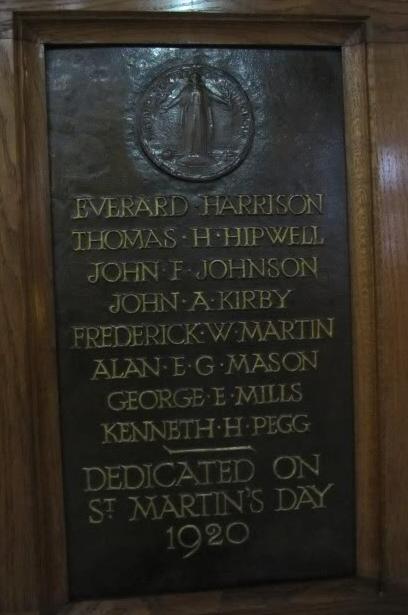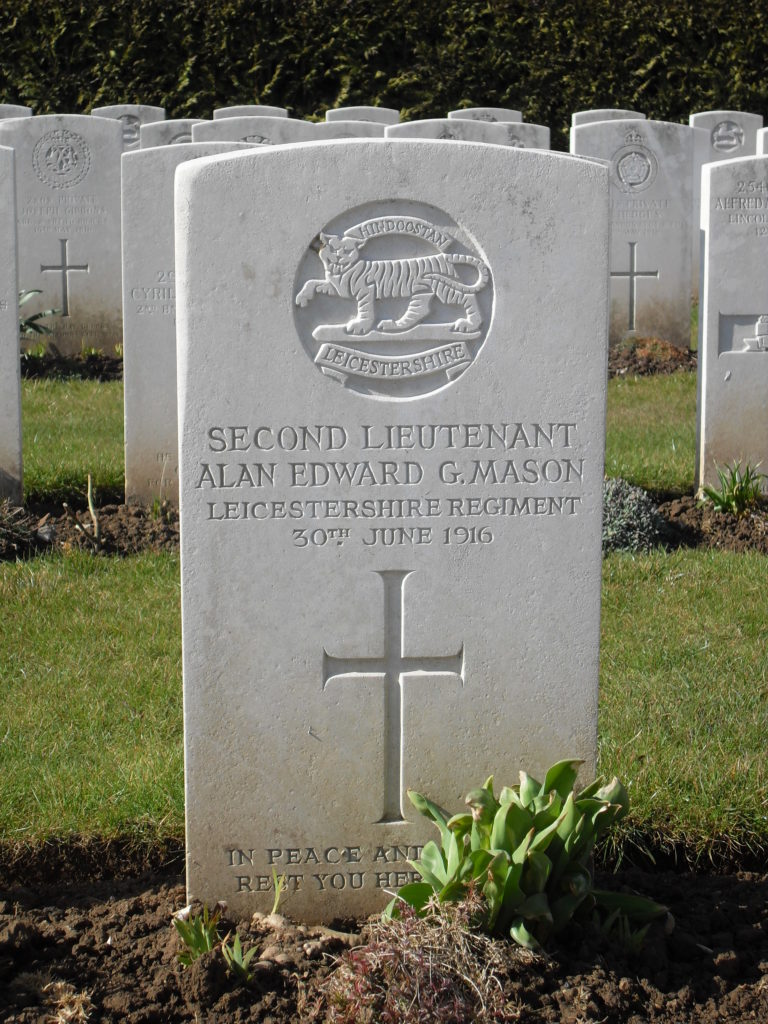Fact file:
Matriculated: Did not matriculate
Born: 22 April 1896
Died: 30 June 1916
Regiment: Leicestershire Regiment
Grave/Memorial: Doullens Communal Cemetery (Extension No. 1): II.A.4
Family background
b. 22 April 1896 at 52, London Rd, Leicester, as the second of the three sons of Dr Henry Mason, MB CM MD (Glasgow) MRCS (1864–1928) and Mrs Cecilia Florence Mason (née Norman) (1867–1962) (m. 1891). At the time of the 1901 Census the family (with one servant) was living at 66, London Rd, Leicester.
Parents and antecedents
Mason’s father, the son of a fairly wealthy Leicestershire farmer, described himself as a physician and surgeon. During World War One he served as a Captain in the Royal Army Medical Corps.
Mason’s mother was the daughter of a land surveyor.
Siblings and their families
Brother of:
(1) Henry Kingsley (1893–1971), who during World War One served in the City of Regina Battalion, the Canadian Expeditionary Force;
(2) Philip de Roos (later MRCS LRCP) (1899–1948), who studied Medicine and returned to Leicester to practise. In 1929 he married Beryl Mary Stevens (1900–56).
“‘He has already brought distinction on the School by his work in the classroom’ and is ‘the best all-round-athlete that the School has ever produced’. ‘A towering figure’, he is ‘the best footballer the school has had for many years past’.”
Education
Mason attended Wyggeston School, Leicester, from 1904 to 1914, and distinguished himself in virtually every activity, finally becoming Captain of the School from 1913 to 1914. The Wyggestonian described him as someone who “had already brought distinction on the School by [his] work in the classroom” and “the best all-round-athlete that the School has ever produced”. Although only 5 foot 8½ inches tall, from 1911 to 1914 he was a member of the first football XI (Captain 1912 to 1914), and The Wyggestonian described him as “a towering figure”, and “the best footballer the school has had for many years past”. He was only a slightly less distinguished cricketer, for when, in 1914, he was Captain of the First XI (Vice-Captain 1913), he topped the batting averages, scored a century and kept wicket. He was also active in debating, chess and athletics, where he generally acted as the hare in cross-country races, and he was the School’s Victor Ludorum in 1912 and 1914, as were both his brothers in other years – Philip de Roos on the day before Alan Edward’s death. Mason was elected to an Open Demyship in Natural Science at Magdalen in March 1913, and his obituarist in the Leicester Mail described him as having “great promise of a brilliant career in his father’s profession” – but he did not matriculate.

Alan Edward Glendenning Mason
(Source: http://www.royalleicestershireregiment.org.uk/entity/106967-mason-alan-edward-glendenning)
War service
On 29 August 1914, Mason attested and became a Private in ‘F’ Company of the 1/4th Battalion (Territorial Forces) of the Leicestershire Regiment, but was subsequently moved to the Regiment’s 10th (Reserve) Battalion. On 25 January 1915 he was finally commissioned Second Lieutenant in the Regiment’s 7th (Service) Battalion and stayed with this unit for the rest of his short life. The 7th Battalion had been formed at Leicester in September 1914, and after training in the Aldershot area, it landed in Boulogne on 30 July 1915 as part of 110th Brigade, in the 37th Division. Mason joined it in France on 25 November 1915, when it was about to return to its billets at Bienvillers-sur-Bois, c.12 miles south-west of Arras, after spending four days in the trenches halfway between Bienvillers and Monchy-au-Bois, about one-and-a-half miles to the east-north-east. The Battalion was in and out of these trenches from then until 10 February 1916: they were, however, in very bad repair, with water up to the men’s waists in the worst places, and the severe weather made things even worse. So much so that the Battalion War Diary ventured the thought that patrolling in no-man’s-land was “a great relief from the monotony of mud”. Moreover, although the Battalion enjoyed Christmas dinners by Companies, its War Diary tells us that “the enemy made no attempt at friendliness or in any way put out ‘feelers’ for a truce opposite this sector”, adding that if it had done so, “both by orders and inclination, there would have been no response”.
On 10 February 1916 the Battalion took over a different sector of the trenches near Berles-au-Bois, which was in the same general area but about three miles to the north, and the extremely unpleasant routine continued afresh, with bad snow from 22 February to 4 March 1916. On 7 March, a raid on the German trenches was staged and three days later the Battalion was back in billets at Berles-au-Bois, where it stayed until 17 March. During this rest period, on 16 March 1916, Mason wrote a letter to his old Headmaster that was published three months later in the June number of The Wyggestonian:
We are all hoping we have seen the last of the cold weather for this year, at any rate, it is now beautifully warm spring weather. Indeed trench life is quite pleasant just at present, and I can imagine many situations worse than sitting in a warm sun watching our artillery attending to the Bosches [sic], with an occasional air encounter thrown in as a diversion. Air fights, however, are very disappointing; you see the opposing planes circling round each other, you hear the distant rattle of their machine guns, but it is only very rarely that anything sensational follows the fight. They generally fly round each other till they get tired of it; they then steer off by mutual consent.
But on 19 March the Battalion marched to Sus-St-Leger, about ten-and-a-half miles to the north-west and well behind the front line, for a period of rest and training that continued until 14 May, when the Battalion returned to Bienvillers-au-Bois and then went back into the trenches from 20 to 26 May. From 26 May to 12 June it rested at Bailleulmont, about four miles to the north, and then spent time in Reserve. Although WO95/2531 stops on 26 June and WO95/2164 has nothing to say about the final days of June 1916, we know from other sources that on 29 June 1916, while leading a diversionary attack on the German trenches near Bienvillers-au-Bois, Mason was seriously wounded by a rifle bullet and a grenade that badly damaged both his legs. Although Private Haynes carried him back to the British lines, he died, aged 20, on 30 June 1916. He is buried in Doullens Communal Cemetery (Extension No. 1), Grave II.A.4, with the inscription “In peace and honour rest you here, my son” (a slight adaptation of line 178 of Act 1, Scene 1, of Shakespeare’s Troilus and Cresside). He is commemorated on a memorial plaque in the Cathedral Church of St Martin, Leicester.

The memorial plaque in the Cathedral Church of St Martin, Leicester, commemorating members of the Parish who were killed in action during World War One. Mason’s name is sixth down on the list.
(Source: http://warmemorials.myfastforum.org/viewtopic.php?t=2193&start=0)
Bibliography
For the books and archives referred to here in short form, refer to the Slow Dusk Bibliography and Archival Sources.
Printed sources:
A.E.G. Mason, [letter to his Headmaster of 16 March 1916], The Wyggestonian, 18, no. 3 (June 1916), pp. 39–40.
[Anon.], ‘Second Lieutenant Alan E.G. Mason’ [obituary], The Times, no. 41,234 (1 August 1916), p. 15 [where his date of death is wrongly given as 7 July 1916].
[Anon.], ‘Death of Lieut. A.E.G. Mason’ [obituary], Leicester Mail, no. 2,060 (3 July 1916), p. 3.
[Anon.], ‘Lieut. A.E.G. Mason’, Leicester Mail, no. 2,061 (4 July 1916), p. 5.
[Anon.], [untitled obituary], The Wyggestonian, 18, no. 4 (July 1916), pp. 39–40.
Archival sources:
MCA: Ms. 876 (III), vol. 2.
MCA: PR 32/C/3/850-851 (President Warren’s War-Time Correspondence, Letters relating to A.G. Mason [1915–1916]).
WO95/2164.
WO95/2530.
WO339/32706.
At Magdalen College, Oxford
In the Year of War, 1916
There are ghosts here –
ghosts in the Magdalen meadows
Where the shy deer glance,
And a marching troop that come as shadows
From the fields of France.
In the Quad, where silver twilight lingers.
And the hush’d bells sound,
There’s a touch – a touch of unseen fingers,
And a Hope unfound.
It seems young voices and boyish laughter
Echo here and there,
But Grief, the comrade who follows after,
Beats at empty air.
Near the chapel arch the carven faces
Peer from lichened wall
To mark where lone Age his way retraces
At the end of all.
From Magdalen Walks Youth has gone forever
On a high enterprise,
And passing, leaves us the haunted river,
And the Bridge of Sighs.
Mabel Leigh
(The Oxford Magazine , 4 May 1917, p. 227)


